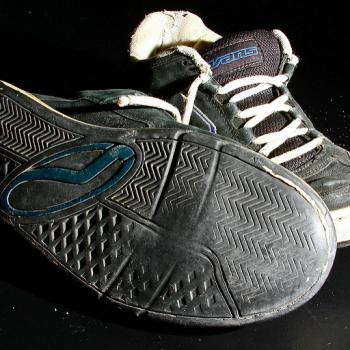The number one thing is, “Don’t send your used shoes.”
Compassionate people plus tough and tragic situations equals a desire to do something, anything, to relieve suffering. So we ask, “how can I help?”
There’s plenty of suffering to go around. From mass near starvation of Syrian refugees to still-unmeasured destruction and death in the Philippines from Typhoon Haiyan to the average, everyday angst that afflicts most everyone–well, we’re just not going to run out of instances that birth the impulse to help.
Where to start?
Don’t send used shoes. Really. Don’t do this. It makes things worse.
One veteran aid worker, pleading for a monetary response to the Philippine disaster, wrote about her experiences after the tsunami that hit South Asia in 2004:
“ . . . well-intentioned people cleaned out their closets, sending boxes of ‘any old shoes’ and other clothing to the countries. . . . Heaps of them were left lying on the side of the road. Cattle began picking at them and getting sick. Civil servants had to divert their limited time to eliminating the unwanted clothes. . . . Boxes filled with Santa costumes, 4-inch high heels, and cocktail dresses landed in tsunami-affected areas. In some places, open tubes of Neosporin, Preparation H, and Viagra showed up. The aid community has coined a term for these items that get shipped from people’s closets and medicine cabinets as SWEDOW—Stuff We Don’t Want.”
But we do want to help.
I’ve also read recently about the tragic ending of many international adoptions. Well-meaning people, hearing about abandoned, hungry, suffering children, rushed to adopt without adequate training. They did not know that years of neglect can so change the brain chemistry of babies and children that no amount of even the healthiest love can help these children learn to trust and bond the way babies who are born into nurturing environments do instinctively. While most adoptions turned out well, possibly as many as 15% have been disastrous, even leading to death of the adoptees.
But people just want to help.
We do, and we so often make things worse. Too many pre-manufactured goods, too many well-intentioned volunteer mission teams, too many shipments of shoes can decimate already seriously wounded economies in nations trying to recover from natural–or human-made–disasters. Too many unexamined motives for rescuing other human beings, too much ignorance about human nature, too much arrogance about our abilities to change the world–and we end up making things much worse.
So what WOULD Jesus do? He healed people who asked–and then told them to get up and get going. He fed the hungry, but only a few times. He ate with sinners–and expected them to stop sinning. He welcomed the little children, but never adopted a suffering or abandoned child. He freed people from their demons–and then stubbornly sent them back into their original neighborhoods.
He didn’t live other people’s lives for them, or make their decisions for them, or insist that they change their ways. He also sadly saw them walk away, and didn’t call them back.
He did take all the dirt and shame and back-stabbing and power-grubbing nastiness into himself and gave back the possibility of freedom from such degradations. But even that was never forced on anyone.
I suspect many were displaced by war, by human agency and by natural disaster during Jesus’ life. He only did what he could in the limitations of time and space to which he confined himself.
I can’t fix the people in the Philippines. I can’t rebuild their houses or bring back to life their dead or find the lost. I can also make sure I don’t send shoes and the clothes I no longer want. But I can send money, prayers and gratefulness for those on the ground there. I can do that even as I do what I can in my own limitations of time and space to which I am confined.















